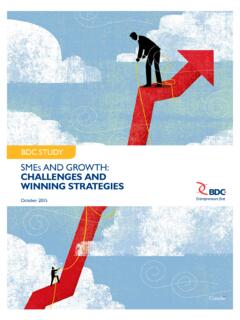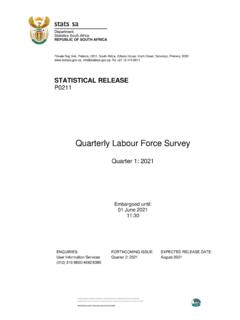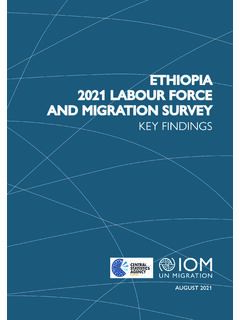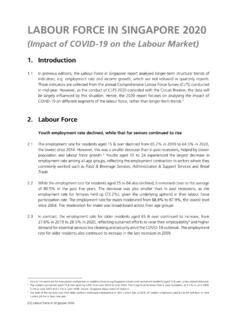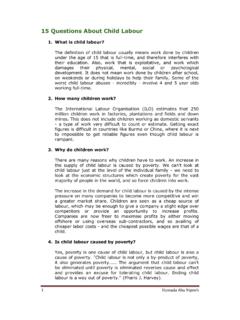Transcription of Labour Shortage: Here to Stay - BDC.ca
1 StudySeptember 2018 Worker Scarcity in Canada and What Businesses Can Do to RespondLabour Shortage: Here to StayTable of contentsHighlights .. 11. No relief in sight .. 32. What is the impact on businesses? .. 43. Where Labour shortages are most acute .. 74. What can you do? .. 105. The benefits of strong human resources policies .. 21A call to action .. 25 Methodology .. 26 Annex A Impact index .. 27 AuthorMichael Cocolakis-Wormstall, Director, Economic Research, author would like to express his sincere appreciation to Alexandra Fioriello, Pierre Cl roux, Fay Hinkson, Isabelle Simard, Julia Shulyak and Mihaela Micu for their support and contributions to this study. This research was prepared by the Economic Analysis team from Marketing and Public Affairs at the Business Development Bank of Canada (BDC). It is based on public and confidential data that were analyzed and interpreted by BDC.
2 Any error or omission is BDC s sole responsibility. Reliance on and use of the information herein is the reader s responsibility. Business Development Bank of Canada, 20181 888 INFO BDC | Design: Ma tre D small and medium-sized businesses are already having difficulty finding new workersThe findings in this study are based on a BDC survey of 1,208 entrepreneurs. The survey asked the owners of small and medium-sized businesses a series of questions to assess the impact of Labour shortages on their company. We also conducted eight telephone interviews with entrepreneurs to better understand the impact of Labour are the highlights of our findings.> Close to 40% of Canadian small and medium-sized businesses are already having difficulty hiring new employees and the situation is getting worse. As our population ages and baby boomers retire, growth in Canada s Labour force is forecast to fall to near zero.
3 We do not expect Labour shortages to get better for at least a decade.> Labour shortages are holding Canadian businesses back. We found a direct link between a shortage of workers and slower growth in company sales. Specifically, our statistical analysis shows that firms that are more affected by Labour shortages are 65% more likely to be low-growth companies.> Labour shortages are most serious in Atlantic Canada, British Columbia and Ontario. We also found the impact differs by size of business it is less acute for very small and very large firms. The sectors facing the strongest headwinds include manufacturing, retail trade and construction.> The most common strategies used by entrepreneurs to combat a Labour shortage involve using less qualified and younger workers, improving efficiency by streamlining processes and requiring staff to work longer hours.> Companies with strong HR policies are more likely to keep current employees, attract new ones and grow sales faster.
4 In fact, our study found businesses with strong HR policies are 66% more likely to generate annual sales growth in excess of 10%.> Entrepreneurs are missing an opportunity by not turning to under-utilized segments of the Labour force to fill their hiring needs. Our study found that among the strategies used to find workers, entrepreneurs were least likely to consider hiring newcomers to Business Development Bank of Canada Labour Shortage: Here to Stay 1If you are having trouble recruiting or retaining employees, you need to get ahead of the problem. This study describes a series of strategies that can help you. Here is an businesses Develop or refine your employee value proposition to make your workplace more attractive to existing and new employees. Hire workers from underutilized segments of the Labour force , including businesses Formalize your HR policies to put your business on a more solid footing and make it more attractive to recruits and existing employees.
5 Improve your operational efficiency by using such tools as key performance indicators, dashboards and process maps. Think about how you could use more technology throughout your business. A good start is to go paperless. Outsource low-value work so you can focus on activities where you have a competitive businesses Standardize and document processes, such as purchasing, production, shipping and client relationship management. Consider investing in an enterprise resource planning system, customer relationship management software, and supply chain and inventory management businesses Work to digitize your production processes and implement other advanced manufacturing techniques. Approaches might include investing in equipment that allows you to monitor and control production in real time, and experimenting with 3D Business Development Bank of Canada Labour Shortage: Here to Stay 1No relief in sightLabour shortages in Canada are, in part, due to the strong demand for workers generated by robust economic growth here and around the world.
6 Real gross domestic product (GDP) is expected to grow globally and in Canada by and , respectively, in 2018. The expansion should continue into 2020, spurring continued healthy demand for the supply side, the growth of Canada s workforce has fallen since 2000 and, despite a recent bump, the downward trend is expected to continue. The decline is a result of the large baby-boom generation heading to retirement. Although immigration should ease the situation, growth in Canada s workforce is expected to stay close to zero in the years ahead. Close to 40% of small and medium-sized businesses are already having difficulty finding new workers, according to our 1 shows Canada s Labour force growth rates since 2000 and projected growth rates to 2030. Notice that the growth rates are expected to remain below for the next decade. The bottom line: Don t expect Labour shortages to get 1 Canada s declining Labour force growth : Statistics Canada, CANSIM 051-0001 and do not expect Labour shortages to get better for at least a Business Development Bank of Canada Labour Shortage: Here to Stay 32 Business Development Bank of Canada Labour Shortage: Here to StayLabour shortages are hurting small and medium-sized enterprises (SMEs) in a number of ways.
7 They lead to unfilled client orders, declining competitiveness and deteriorating product/service quality, among other problems. In fact, according to our findings, businesses that suffer more from Labour shortages grow more slowly. Our analysis indicates that a firm that is more affected by Labour shortages is 65% more likely to be a low-growth finding comes from an index we developed to help assess the impact of Labour shortages on SMEs. The index accounts for the type and scale of impacts on businesses. For example, not being able to fill a client order or providing poor quality work is likely to hurt a business more in the long term than having to raise wages. The index takes this, and other differences, into 2 illustrates the relationship between sales growth and the Labour shortages impact index. The average index value for all firms we surveyed is set to equal 100.
8 Higher index values indicate that a firm is more affected by Labour shortages. Notice that businesses with negative or zero sales growth suffer more from the shortages, with index scores above the average of 100, whereas firms with sales growth of 10% or higher have index scores well below the average. This confirms other findings in the survey and feedback from entrepreneurs the shortage of workers in Canada is holding SMEs back. Please see Annex A for more details on how we calculated the index your company is having trouble hiring workers, you should be proactive about solving the issue. See the What you can do section of this study for advice on how to tackle the For the purposes of this analysis, a low-growth firm is defined as a company with annual sales growth of less than 10%.Businesses that suffer more from Labour shortages grow more slowlyWhat is the impact on businesses?
9 24 Business Development Bank of Canada Labour Shortage: Here to StayFigure 2 Labour shortages slow revenue growthTo what extent has the Labour shortage affected your business (as measured by BDC s Labour shortage impact index)?Annual sales growth20%+ to to to valueSource: Maru/Matchbox survey on Canada s Labour shortage, 2018. Results exclude respondents who said, I don t know or I prefer not to answer. Data are filtered to exclude firms with less than $500,000 in annual sales. Results are weighted by region and company size to reflect Canada s economy more accurately. n = Business Development Bank of Canada Labour Shortage: Here to Stay 54 Business Development Bank of Canada Labour Shortage: Here to StayHow Labour shortages hurt SMEsBecause of Labour shortages, 56% of entrepreneurs said existing staff must work more, while 47% of respondents said they have had to raise wages.
10 Another 43% said a shortage of workers limits growth. Many entrepreneurs also said their companies have been unable to fill or have delayed orders, that they have become less competitive and that the quality of their goods/services has impact of missed or delayed orders, lower competitiveness, and quality problems on a business is self-evident. The indirect costs of Labour shortages are more subtle but no less damaging. During the telephone interviews, entrepreneurs noted they pay an opportunity cost when senior staff are forced to spend more time on the shop floor because of a lack of workers. More time spent supporting production means less time spent on new projects, nurturing client relationships and other high-value activities. These missed opportunities hold a firm back relative to peers and hinder its 3 Impact of Labour shortages on SMEsDue to a work more hoursWe are less competitiveWe raise wages/improve benefits Our quality is deterioratingGrowth is limitedWe are unable to fulfill or delay orders Source: Maru/Matchbox survey on Canada s Labour shortage, 2018.


